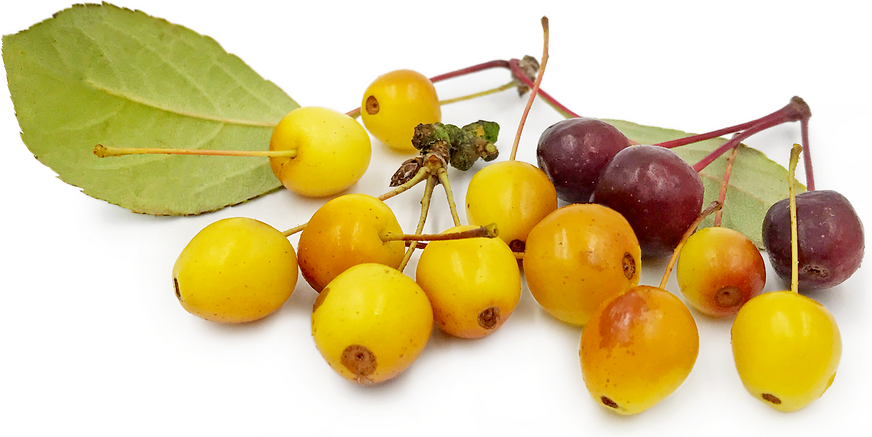


European Crabapples
Estimated Inventory, lb : 0
Description/Taste
European crabapples are very small, measuring between 2 and 4 centimeters in diameter, about the size of large blueberries or small grapes. The fruits are not perfectly round and may have a slightly ribbed appearance. They have long stems like cherries and mature from a yellow-green to red. Their creamy white flesh has a tart, acidic flavor. European crabapples left on the tree will develop more sugars in the flesh, resulting in a sweeter taste.
Seasons/Availability
European crabapples are available in the fall and through the winter months.
Current Facts
European crabapples are a wild variety of apple known botanically as Malus sylvestris. In 2012, researchers found that European crabapples were a major genetic contributor to the modern domesticated apple. The name ‘crabapple’ generally refers to any apple that measures under 5 centimeters in diameter. The so-called ‘crabby’ appearance of the tree, as well as the fruit’s astringent taste, led to its common name.
Nutritional Value
European Crabapples are rich in vitamin C and fiber. They contain high amounts of phenols, which along with the vitamin C content, provide excellent antioxidant benefits. They are a source of magnesium, iron, potassium, and B-complex vitamins.
Applications
European crabapples are generally cooked prior to eating, due to the taste and texture of the raw fruit. European crabapples are used most often for their high pectin and acid content, which makes them ideal for jams and jellies, but also a good substitute for pectin for other jams. The tart fruits pair well with raspberries, blueberries, gamey meats, poultry, and creamy cheeses. They can be used to make sauces or pressed for their juice for use in cocktails, ciders and ales. In Britain, they are pickled. Roast halved or whole European crabapples alongside meats. European crabapples will keep for up to a month in a cool, dry space. Refrigerate for extended storage.
Ethnic/Cultural Info
The wood of the European crabapple tree has a pink tinge and a sweet smell. It was burned in fertility rites and religious ceremonies by the ancient Celts of Britain. The wood is also used for making furniture and is ideal for carving and turning. European crabapples have appeared in literature and writing throughout history, namely in two of Shakespeare’s plays: A Midsummer Night's Dream and Love's Labour Lost.
Geography/History
European crabapples are native to Central Europe, their range extending from the United Kingdom in the northeast to Turkey in the eastern Mediterranean region. Researchers mapped the genome of the domesticated apple and discovered that the European crabapple is descendant from the species Malus sieversii, which is native to the western Tien Shan mountains of Kyrgyzstan. This region, which also includes Tajikistan, Turkmenistan, and Uzbekistan is home to over 300 wild fruit and nut trees and is where apples were first domesticated. From this fertile region, apples moved along the Silk Road with traders and travelers. European crabapples still grow in the wild and are cultivated in some areas of Europe and the United Kingdom. There is very little mass commercial value for these fruits, so they are more likely spotted at local farmer’s markets and in backyard gardens in the United States.
Recipe Ideas
Recipes that include European Crabapples. One




